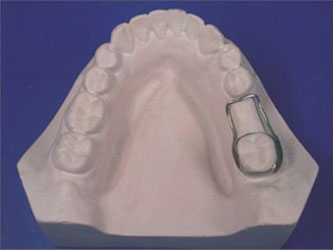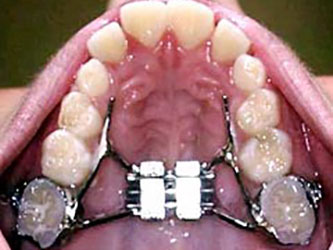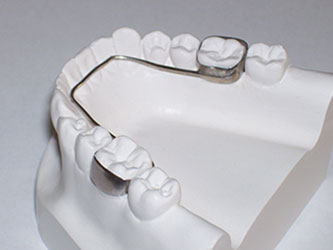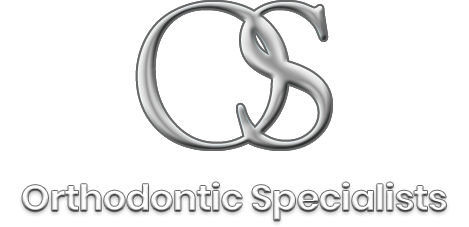Interceptive Orthodontics
Orthodontic Space Maintainers
 This appliance maintains space when a tooth is lost earlier than the natural sequence. In doing so, it prevents the tooth from shifting. The loss of a tooth space due to shifting will cause crowding in the adult dentition.
This appliance maintains space when a tooth is lost earlier than the natural sequence. In doing so, it prevents the tooth from shifting. The loss of a tooth space due to shifting will cause crowding in the adult dentition.
Key Benefits
- Maintains space needed for the transition from primary (baby) teeth to adult teeth
- Prevents loss of space and further crowding in the adult teeth
- Can prevent the need for full orthodontic treatment
Critical Key to Success
The patient needs to be seen in a timely manner, so as to not lose space for the adult teeth.
- Advantage 1: Our Office provides a recall system of appointments in order to treat your child on a timely basis.
- Advantage 2: Our Recall monitoring of your child's growth and development is free of charge.
Palatal Expanders
 This orthodontic device widens the upper arch. It is suitable for patients with inadequate arch width.
This orthodontic device widens the upper arch. It is suitable for patients with inadequate arch width.
Key Benefits
- Improves occlusion
- Enhances nasal breathing
- Improves facial aesthetics
Critical Fact
This procedure must be accomplished prior to 13 years of age. The fusion of the Palatal Process, (roof of the mouth), takes place at age 13. Once closed, this prohibits the procedure from being successful in the widening of the upper arch.
Advantages
- Allows the teeth to mesh in the proper manner
- Increases nasal airway, thus easing breathing and oxygenation of blood
- Maintains facial symmetry, which is the basis of attractive facial characteristic
Records & Consult
In order to make a correct diagnosis and establish a specific treatment plan for the particular malocclusion, we formulate a record on each patient. The records appointment last for half-an-hour.
Records Procedures
- Clinical Exam
- X-rays: Panoramic and Cephalometric
- Photography of the facial and intraoral aspects of the patient
- Models of both arches
Treatment Plan Development
This gives the doctor the ability to see the problem in all of its dimensions, including crowding within the arch, the development of teeth and the overall effect the problem has on the person's facial appearance. Once collected, the information is analyzed in the formulation of a specific treatment plan for the patient.
Consultation
The consultation appointment is usually two weeks after the records appointment and last for half-an-hour.
- Goal #1: To present all the gathered information and get feedback regarding the aesthetic concerns of the patient.
- Goal #2: To explain the challenges of the specific treatment to the patient and what is needed to achieve our goals.
- Goal #3: To answer every question the patient and parents may have regarding the treatment plan.
Lingual Arch Space Maintainer
 Following the extraction of a primary posterior tooth, adjacent teeth may move into the space. This could lead to improper tooth eruption, resulting in crooked teeth, which may contribute to decay and periodontal disease. A lingual arch space maintainer prevents unwanted shifting of the permanent lower molars. It hinders the molars from moving forward and blocking the space where future teeth will develop. This appliance is often used following the premature loss of primary (baby) teeth. If teeth move into the empty space, unerupted future adult teeth may become impacted or stuck. Due to the loss of space, crowding can occur. Children experiencing this problem will need orthodontic treatment later in life to correct it.
Following the extraction of a primary posterior tooth, adjacent teeth may move into the space. This could lead to improper tooth eruption, resulting in crooked teeth, which may contribute to decay and periodontal disease. A lingual arch space maintainer prevents unwanted shifting of the permanent lower molars. It hinders the molars from moving forward and blocking the space where future teeth will develop. This appliance is often used following the premature loss of primary (baby) teeth. If teeth move into the empty space, unerupted future adult teeth may become impacted or stuck. Due to the loss of space, crowding can occur. Children experiencing this problem will need orthodontic treatment later in life to correct it.
A lingual arch is fitted into the mouth by placing bands on the molars and connecting them to a wire that fits against the inside of the lower teeth. It must stay in place until the adult tooth erupts in the space.
